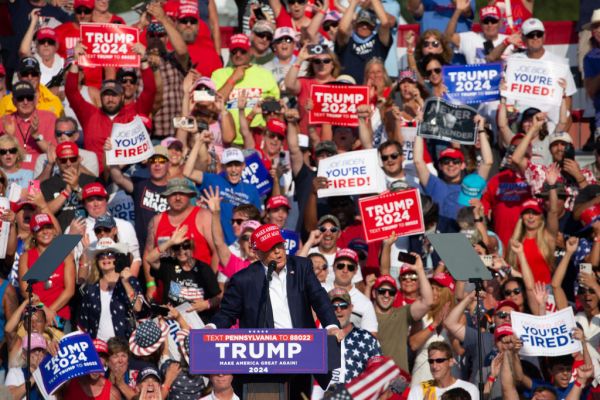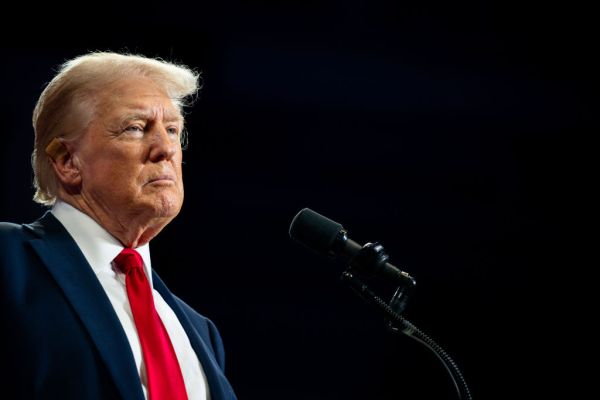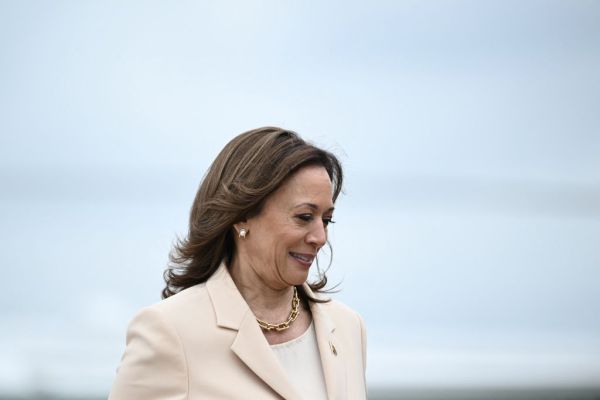By the time Donald Trump concluded his speech at the Ellipse on January 6, 2021, members of the Proud Boys had already breached the Capitol complex’s outside perimeter—delineated by bike-rack fencing and manned by Capitol Police officers. According to former White House aide Cassidy Hutchinson’s June 28 testimony before the House select committee investigating that day, Trump had been under the impression that he would be going to the Capitol with the crowd he had sent in that direction, and he was “irate” that his Secret Service detail prevented him from doing so.
Over the next three hours, protesters stormed the Capitol and came close to Vice President Mike Pence. All the while, Trump was at the White House, watching Fox News from the dining room next to the Oval Office and tweeting several times, asking an already violent mob to be “peaceful.”
The House select committee focused Thursday’s primetime hearing on the time period between 1:10, when Trump’s speech ended, and 4:17, when he sent a tweet asking his supporters to go home—187 minutes of inaction, as the committee billed it.
“Doors have opened, new subpoenas have been issued, and the dam has begun to break,” committee vice chair Rep. Liz Cheney said in her opening statement. Cheney, who led the committee after Chairman Rep. Bennie Thompson tested positive for COVID on Tuesday, explained that the committee will continue to gather information in August before convening for further public hearings in September.
Retired Sgt. Mark Robinson of the Metropolitan Police, who said he had been part of more than 100 presidential motorcades and was near the Ellipse on January 6, testified to the committee via video that he was told Trump was “adamant” that he wanted to go to the Capitol and got into a “heated” argument with his Secret Service agents about it. Even after Trump had returned to the White House, Robinson said the presidential motorcade was “on standby” for another 45 to 60 minutes waiting for the Secret Service to make a final determination about the proposed trip to the Capitol.
Having been denied that trip, Trump was in the dining room next to the Oval Office by 1:25 p.m., where he watched the events at the Capitol unfold on Fox News. He stayed there until 4 p.m.
There is a lot we do not know about what Trump was doing during this time. While presenting evidence, Democratic committee member Rep. Elaine Luria noted that the official presidential phone records and diary are empty, and she said that the chief White House photographer wanted to take photographs of the president but was told not to.
Despite this lack of official records, the committee learned from others’ records and from witness testimony that Trump did make some phone calls. Kayleigh McEnany, the White House press secretary at the time, said in her deposition that she had provided the president with a list of senators at his request. Among the senators he called were Tommy Tuberville of Alabama and Josh Hawley of Missouri.
(The Trump team’s efforts to pressure senators to delay the certification of the electoral votes continued into the evening of January 6, as evidenced by a voicemail Rudy Giuliani intended to leave for Tuberville, first reported by The Dispatch and played at the hearing on Thursday.)
We also know that, in former White House counsel Pat Cipollone’s words, “many” members of Trump’s White House staff were agitating for a more forceful response from the president. In his deposition, clips of which were aired Thursday, Cipollone could not recall a single member of the staff who approved of the attack.
But Trump continued to pour fuel on the fire. Cipollone testified that the president did not call the secretary of defense, the attorney general, or the secretary of homeland security. In contrast, Gen. Mark Milley, chairman of the Joint Chiefs of Staff, testified that Vice President Mike Pence was “animated” and “direct” in his orders from a secure location in the Capitol complex.
At any point, Trump could have walked down a hallway to the White House press briefing room and called off the mob. He declined to do so—and, critically, he was the only person who could have done so effectively. “It was obvious that only President Trump could end this,” then-Senate Majority Leader Mitch McConnell said on the Senate floor the next month as Trump’s second impeachment trial drew to a close. (McConnell voted not to convict.)
As in previous hearings, the committee heard live witness testimony—this time from Matthew Pottinger, a former deputy national security adviser in the Trump White House who resigned on January 6, and Sarah Matthews, a former deputy press secretary who also quit her post over Trump’s response to the attack. But perhaps the most striking testimony of the night was both asynchronous and anonymous. The committee played audio clips of witnesses who worked on national security issues in the White House, with their voices disguised to protect their privacy. One of these witnesses testified about the internal communications of national security professionals who were listening remotely to the radio traffic of Secret Service agents at the Capitol as the attack unfolded.
This anonymous witness said that radio traffic after the breach of the Capitol building at 2:13 became “disturbing” and involved chaos and yelling. While in the process of moving Vice President Mike Pence to a secure location, his detail struggled to find a path safe from the rioters before eventually making a move at 2:16. Around this time, an internal message among the group of national security staffers said that the Secret Service at the Capitol “does not sound good.” The witness said agents sounded like they feared for their lives and were saying goodbye to family members.
At 2:24 p.m. Trump sent a tweet berating Pence for his lack of courage. Moments later the violence escalated, and Pence had to be moved a second time.
Trump tweeted three more times: At 2:38 he told the already-violent mob to “stay peaceful” and at 3:13 he said to “remain peaceful.” According to Thursday’s testimony, Trump was resistant to use even this language and had to be talked into it by his daughter, Ivanka. Finally, at 4:17, he sent a tweet asking the mob to go home.
The committee also unveiled never-before-seen outtake footage of the Rose Garden video message Trump finally tweeted at 4:17 as well as the speech he delivered the following evening. In his January 7 speech, Trump still could not bring himself to say that the election was over, limiting himself to language about how “Congress has certified” the results.
Throughout the hearing, the committee emphasized the importance of the oath of office to America’s public servants—and its apparent unimportance to Trump.
Rep. Adam Kinzinger—who, along with Luria, oversaw much of Thursday’s hearing—said in his closing statement that “whatever your politics—whatever you think about the outcome of the election—we as Americans must all agree on this: Donald Trump’s conduct on January 6 was a supreme violation of his oath of office and a complete dereliction of his duty to our nation.”
For her part, Cheney harshly criticized Trump for manipulating his supporters in his effort to stay in power.
“Donald Trump knows that millions of Americans who supported him would stand up and defend our nation were it threatened. They would put their lives and their freedom at stake to protect her. And he is preying on their patriotism. He is preying on their sense of justice. And on January 6, Donald Trump turned their love of country into a weapon against our Capitol and our Constitution.”
Cheney added that Trump’s violation of his oath of office was a “purposeful choice.”
Kinzinger, Luria, and Cheney also emphasized that the committee understands the gravity of its undertaking. In its final report, the committee will offer legislative recommendations to prevent a future January 6. But legislation alone won’t be enough, he said.
“The forces Donald Trump ignited that day have not gone away,” Kinzinger said. “The militant intolerant ideologies, the militias, the alienation and the disaffection, the weird fantasies and disinformation—they’re all still out there ready to go.” Laws, he said, “mean nothing without public servants dedicated to the rule of law and who are held accountable by a public that believes oaths matter more than party tribalism or the cheap thrill of scoring political points.”









Please note that we at The Dispatch hold ourselves, our work, and our commenters to a higher standard than other places on the internet. We welcome comments that foster genuine debate or discussion—including comments critical of us or our work—but responses that include ad hominem attacks on fellow Dispatch members or are intended to stoke fear and anger may be moderated.